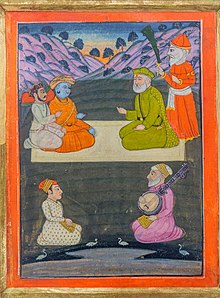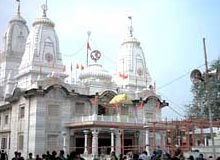Gorakhnath
Gorakhnath | |
|---|---|
Matsyendranath | |
| Honors | Mahayogi |
Gorakhnath (also known as Goraksanath (Sanskrit: Gorakṣanātha),
He was one of nine saints, or Navnath, and is known in Maharashtra, India.[6] Hagiographies describe him to be a person outside the laws of time who appeared on earth during different ages.[7] Historians agree that Gorakhnath lived sometime during the first half of the 2nd millennium CE, but there is some disagreement about which century he lived. Estimates based on archaeological and textual evidence range from Briggs' estimate of the 11th to 12th century[7] to Grierson's estimate of the 14th century.[8]
Gorakhnath is considered a Maha-yogi (or "great yogi") in Hindu tradition.
Gorakhnath, his ideas, and his yogis have been popular in rural India, with monasteries and temples dedicated to him found in many states of India, particularly in the eponymous city of Gorakhpur.[10][11]
Biography
Historian accounts

Historians disagree on when Gorakhnath lived. Briggs estimates 11th to 12th century,
Historical texts imply that Gorakhnath was a
Hagiographic accounts
The
Available hagiographies offer varying records of the spiritual descent of Gorakhnath. All name
Nath Sampradaya

The
Legends state that Gorakhnath and Matsyendranath did penance in Kadri Temple at Mangalore, Karnataka. They were also instrumental in laying Shivlingam at Kadri and Dharmasthala.The temple of Gorakhnath is situated on hill called Garbhagiri near Vambori, Tal Rahuri; Dist Ahmednagar. There is also a temple of Gorakhnath in the state of Odisha.
Gorakhnath Math

The Gorakhnath Math is a monastery of the Nath monastic group named after the medieval saint, Gorakhnath (c. 11th century), of the Nath sampradaya. The math and town of Gorakhpur in Uttar Pradesh is named after him. The monastery and the temple perform various cultural and social activities and serve as the cultural hub of the city. The monastery also publishes texts on the philosophy of Gorakhnath.[20]
A shrine existed at the site from older times which was converted into a mosque by Ala-ud-din Khilji.[21] A smaller shrine was built by Nath Sampraday's followers at a later time. Later additions were made in 18th, 19th and 20th century by devotees and yogis of the order. The math is situated in a Muslim majority area and is a centre of syncretism among devotees and visitors from diverse communal background.[22]
Influence
Hatha yoga
Some scholars associate the origins of
While the origins of Hatha yoga are disputed, according to Guy Beck, a professor of Religious Studies known for his studies on Yoga and music, "the connections between Goraknath, the Kanphatas and Hatha yoga are beyond question".[1]
Langars (community kitchens)

According to Arvind-Pal Singh Mandair, a professor in Asian languages and cultures, the Gorakhnath orders were operating free community kitchens in Punjab before Guru Nanak founded Sikhism.[28][29] Gorakhnath shrines have continued to operate a langar and provide a free meal to pilgrims who visit.[30]
Nepal
The
, a historical district of Nepal, is also named after him.A cave exists in Gorkha with his paduka (footprints) and an idol.[32] Every year, on the day of Baisakh Purnima, a celebration known as Rot Mahotsav takes place in the cave; it has purportedly been celebrated for the last seven hundred years.[33][34]
According to William Northey and John Morris, legend states that a disciple of Machendra by name Gorakhnath once visited Nepal and retired to a small hill near Deo Patan. There, he meditated in an unmovable state for twelve years. The locals built a temple in his honour there.[35]
Siddhar tradition
In the Siddhar tradition of Tamil Nadu, Gorakhnath is one of the 18 esteemed Siddhars of yore, and is also known as Korakkar.[36] Siddhar Agastya and Siddhar Bhogar were his gurus. There is a temple in Vadukku Poigainallur, Nagapattinam, Tamil Nadu which specifically houses his Jeeva Samadhi.[37] According to one account, he spent much of his youth in the Velliangiri Mountains, Coimbatore.
There are various other shrines honouring
West Bengal – Assam – Tripura - Bangladesh
The
Works
Romola Butalia, an Indian writer of Yoga history, lists the works attributed to Gorakhnath as including the Gorakṣaśataka, Goraksha Samhita, Goraksha Gita, Siddha Siddhanta Paddhati, Yoga Martanda, Yoga Siddhanta Paddhati, Yogabīja, Yogacintamani.[citation needed]
Siddha Siddhanta Paddhati
The Siddha Siddhanta Paddhati is a
The Siddha Siddhanta Paddhati text is based on an
This idea appears in the text in various forms, such as the following:The four varna (castes) are perceived to be located in the nature of the individual, i.e. Brahmana in sadacara (righteous conduct), Ksatriya in saurya (valor and courage), Vaisya in vyavasaya (business), and Sudra in seva (service). A yogin experiences all men and women of all races and castes within himself. Therefore he has no hatred for anybody. He has love for every being.
— Gorakhnath, Siddha Siddhanta Paddhati III.6-8 (Translator: D Shastri)[44]
See also
- Gorakh Aya
- Maya Machhindra
- Gorakhnath Temple
- Yogi Nath
- Gorakh Hill
- Korakkar
- Ratan Nath Temple
- Tilla Jogian
- List of Hindu gurus and saints
References
- ^ a b Guy L. Beck 1995, pp. 102–103.
- ^ a b "Hatha Yoga". Encyclopædia Britannica. 2007. Retrieved 3 April 2017.
- ISBN 978-0-8108-3327-2.
- ^ Briggs 1938, p. 228.
- ^ Briggs 1938, p. 1.
- ^ Briggs 1938, pp. 228–250.
- ^ a b c d Briggs 1938, p. 249.
- ^ Briggs 1938, pp. 228–230.
- ^ a b c Akshaya Kumar Banerjea 1983, pp. 23–25.
- ^ White, David Gordon (2012), The Alchemical Body: Siddha Traditions in Medieval India, University of Chicago Press, pp. 7–8
- ISBN 978-1438438900, pp. x–xi
- ^ a b Briggs 1938, pp. 230, 242–243.
- ^ Briggs 1938, pp. 236–242.
- ^ Briggs 1938, pp. 229, 233–235.
- ^ Akshaya Kumar Banerjea 1983, pp. xli, 303–307.
- ^ Akshaya Kumar Banerjea 1983, pp. xli, 307–312.
- ^ a b c Briggs 1938, p. 229.
- ^ Briggs 1938, pp. 229–231.
- ^ "Discipleship". Archived from the original on 5 September 2015. Retrieved 13 May 2007.
- ^ Akshaya Kumar Banerjea 1983, p. [page needed].
- ^ Briggs 1938.
- S2CID 157212381.
- ^ S2CID 161393103.
That these Nāth Yogīs were the originators and foremost exponents of haṭhayoga is a given of all historical studies of yoga. But these Yogīs were in fact the willing and complicit beneficiaries of the semantic confusion which has caught out White and many other scholars
- ^ Gerald James Larson, Ram Shankar Bhattacharya & Karl H. Potter 2008, p. 140.
- ^ James Mallinson 2011, pp. 331–332 with footnote 22.
- ^ James Mallinson 2012, pp. 26–27.
- ^ James Mallinson 2012, pp. 26–27, Quote: "Thee key practices of hathayoga—including complex, non-seated āsanas [...] whose first descriptions are found in Pāñcarātrika sources—originated among the forerunners of the Dasnāmīs and Rāmānandīs.".
- ISBN 978-1-4411-1708-3.
- ^ "Arvind-Pal Singh Mandair: Bloomsbury Publishing (US)". Bloomsbury Publishing. Retrieved 9 March 2022.
- ISBN 978-1-84553-234-5.
- ^ a b Gerald James Larson, Ram Shankar Bhattacharya & Karl H. Potter 2008, pp. 440–441.
- ^ "Gorkha: The Historical Landmark of Nepal". Nepal Sanctuary Treks. 10 September 2018. Retrieved 15 June 2020.
- ^ Gauron, Julianne. "Nepal's Rot Festival at Gorhka's Durbar Palace". SNOW ON THE ROAD.
- ^ "Brief Introduction". District Coordination Committee Office Gorkha.
- ^ Northey, W. B.; Morris, C. J. (2001). The Gurkhas: Their Manners, Customs, and Country. Asian Educational Services.
- ^ R. N. Hema (December 2019). Biography of the 18 Siddhars (Thesis). National Institute of Siddha.
- ^ "18 Siddhars". www.satsang-darshan.com. Archived from the original on 12 May 2023. Retrieved 12 May 2023.
- ^ R. N. Hema (December 2019). Biography of the 18 Siddhars (Thesis). National Institute of Siddha.
- ISBN 978-81-208-0564-4.
- ^ Bhaṭṭācārya, Āśutosha (1978). Folklore of Bengal. National Book Trust, India. p. 124,132.
- S2CID 259185097.
- ^ Feuerstein, Georg (1991). 'Holy Madness'. In Yoga Journal May/June 1991. With calligraphy by Robin Spaan. Source: p. 105 (accessed: 29 February 2011)
- ^ Gerald James Larson, Ram Shankar Bhattacharya & Karl H. Potter 2008, p. 453.
- ^ Gerald James Larson, Ram Shankar Bhattacharya & Karl H. Potter 2008, p. 440.
Sources
- Akshaya Kumar Banerjea (1983). Philosophy of Gorakhnath with Goraksha-Vacana-Sangraha. Delhi: Motilal Banarsidass. ISBN 978-8120805347.
- Briggs, G.W. (1938). Gorakhnath and the Kanphata Yogis (6th ed.). Motilal Banarsidass. ISBN 978-8120805644. (2009 Reprint)
- Guy L. Beck (1995). Sonic Theology: Hinduism and Sacred Sound. Motilal Banarsidass. ISBN 978-81-208-1261-1.
- ISBN 978-81-208-3349-4.
- James Mallinson (2011). "Siddhi and Mahāsiddhi". In Knut Jacobsen (ed.). Early Haṭhayoga in Yoga Powers: Extraordinary Capacities Attained Through Meditation and Concentration. Leiden: Brill Academic. pp. 327–344.
- James Mallinson (March 2012). "Yoga and Yogis". Namarupa. 3 (15): 1–27.
- S2CID 170326576.
Further reading
- Adityanath (2005). Gorakhnath[permanent dead link]. Retrieved 7 March 2006.
- ISBN 81-208-1947-0
- Dhallapiccola, Anna. ISBN 0-500-51088-1
- Gordan Djurdjevic & Shukdev Singh, Sayings of Gorakhnāth: Annotated Translation of the Gorakh Bānī, ISBN 9780199977673, Oxford University Press, 2019.
- Mahendranath, Shri Gurudev. Notes on Pagan India. Retrieved 7 March 2006.
External links
- Works by or about Gorakhnath at Internet Archive
- Bibliography of Goraksanatha's works, Item 666 Archived 13 November 2021 at the Wayback Machine, Karl Potter, University of Washington

